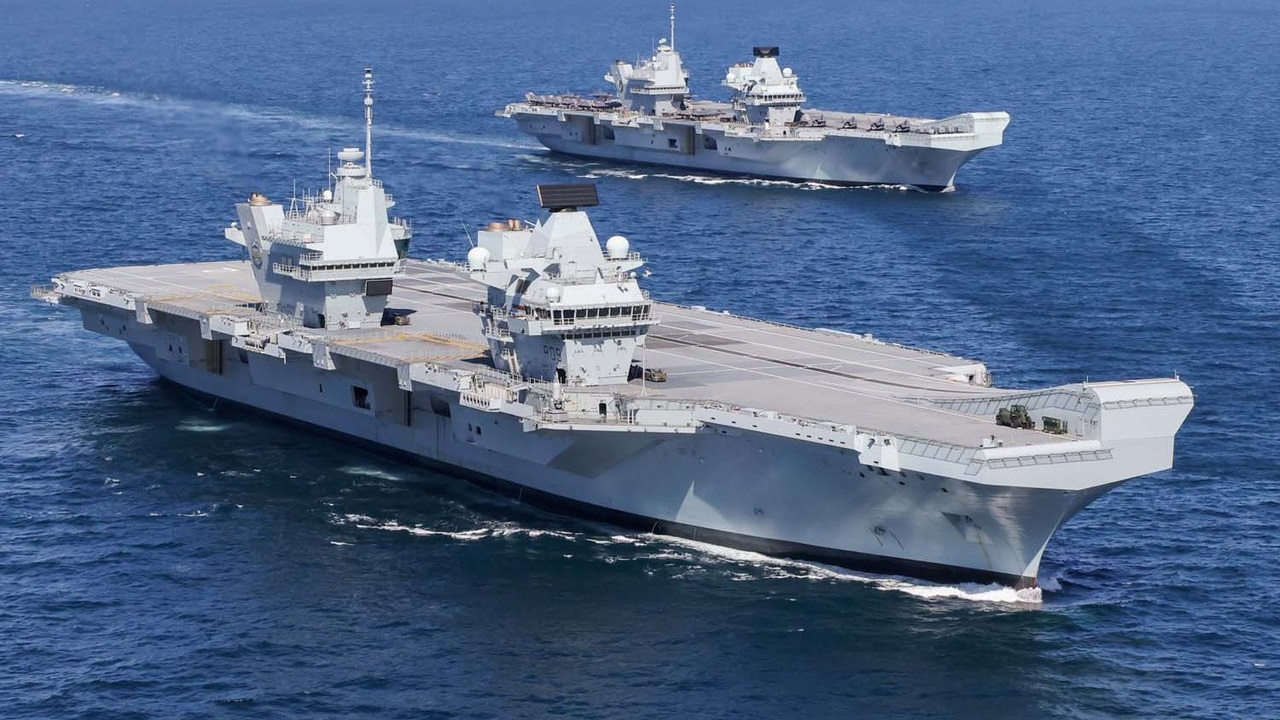The UK’s Royal Navy may be exhibiting a bit of “buyer’s remorse” with its aircraft carriers – and not just due to the fact that HMS Prince of Wales broke down last year and has been undergoing an expensive repair that has taken the NATO flagship out of service. It was reported this month that the Royal Navy is now studying how to retrofit its new flattops with assisted launch systems and recovery gear.
Currently, the UK’s Queen Elizabeth-class (QEC) carriers are able to operate with short takeoff and vertical landing (STOVL) fixed-wing aircraft – notably the Lockheed Martin F-35B Lightning II – as well rotary aircraft including a variety of helicopters.
In its current configuration, the QEC flight deck is fitted with a 12.5-degree ski ramp forward and a vertical recovery deck offset to port. There is no assisted launch or arrestment machinery installed.
Adding Catapults?
At last month’s Defence Leaders’ “Combined Naval Event 2023” conference in Farnborough in the UK, Colonel Phil Kelly, head of Carrier Strike and Maritime Aviation within the Royal Navy’s Develop Directorate, outlined an ambitious plan that could see significant modifications made to the carriers. It would see the retrofit of arrestor gear and assisted launch equipment as part of a broader Future Maritime Aviation Force (FMAF) vision.
FMAF is a multi-strand program that is exploring the widespread fielding of uncrewed aviation across the surface fleet, with a specific focus on future carrier aviation Naval News first reported.
Project Ark Royal
Also known as Project Ark Royal, it would call for a phased introduction of aircraft launch and recovery equipment that could enable the operation of high-performance uncrewed strike and support systems including drones, as well as potentially fixed-wing crewed aircraft.
“We are looking to move from STOVL to STOL [short takeoff and landing], then to STOBAR [short takeoff but arrested recovery] and then to CATOBAR [catapult assisted takeoff but arrested recovery]. We are looking at a demonstrable progression that spreads out the financial cost and incrementally improves capability,” Kelly said during the conference.
Kelly further noted that this November will see a test launch of a Mojave STOL aircraft off the angle of the flight deck, while he added that “Adding catapults would allow us to operate the heaviest aircraft you can imagine.”
Naval News further reported that various assisted launch and recovery system options have already been reviewed under Project Ark Royal. These include the Electromagnetic Aircraft Launch System and Advanced Arrestor Gear equipment being delivered by General Atomics for the United States Navy’s Gerald R. Ford-class aircraft carriers, as well as the UK’s own Electro Magnetic Kinetic Induction Technology demonstrator – developed by GE Power Conversion.
Playing Catch-up With Beijing
The changes to the carriers could be a reaction to the fact that China’s Type 003 Fujian could have capabilities that are close to those of U.S. carriers – notably the inclusion of electromagnetic catapults.
The People’s Liberation Army Navy (PLAN) will soon have three aircraft carriers to the Royal Navy’s two flattops, and while two are similar in size and design to the QEC, clearly the third will be more advanced. The Royal Navy won’t like losing its edge as the UK is still struggling to achieve its “Global Britain” ambitions.
Author Experience and Expertise
A Senior Editor for 19FortyFive, Peter Suciu is a Michigan-based writer. He has contributed to more than four dozen magazines, newspapers, and websites with over 3,200 published pieces over a twenty-year career in journalism. He regularly writes about military hardware, firearms history, cybersecurity, politics, and international affairs. Peter is also a Contributing Writer for Forbes and Clearance Jobs. You can follow him on Twitter: @PeterSuciu.
From 19FortyFive
Ukraine Footage Shows U.S. M982 ‘Excalibur’ Cut Through Russian Artillery
How To Sink A $3 Billion Dollar Submarine: Leave A Hatch Open
Smashed To Pieces: Video Shows Ukraine Hitting Russian Air Defenses

